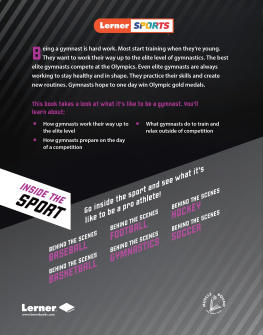Thank you for downloading this Touchstone eBook.
Join our mailing list and get updates on new releases, deals, bonus content and other great books from Touchstone and Simon & Schuster.
C LICK H ERE T O S IGN U P
or visit us online to sign up at
eBookNews.SimonandSchuster.com
We hope you enjoyed reading this Touchstone eBook.
Join our mailing list and get updates on new releases, deals, bonus content and other great books from Touchstone and Simon & Schuster.
C LICK H ERE T O S IGN U P
or visit us online to sign up at
eBookNews.SimonandSchuster.com

Touchstone
An Imprint of Simon & Schuster, Inc.
1230 Avenue of the Americas
New York, NY 10020
www.SimonandSchuster.com
Copyright 2016 by Dvora Meyers
All rights reserved, including the right to reproduce this book or portions thereof in any form whatsoever. For information, address Touchstone Subsidiary Rights Department, 1230 Avenue of the Americas, New York, NY 10020.
First Touchstone hardcover edition July 2016
TOUCHSTONE and colophon are registered trademarks of Simon & Schuster, Inc.
For information about special discounts for bulk purchases, please contact Simon & Schuster Special Sales at 1-866-506-1949 or .
The Simon & Schuster Speakers Bureau can bring authors to your live event. For more information or to book an event, contact the Simon & Schuster Speakers Bureau at 866-248-3049 or visit our website at www.simonspeakers.com.
Parts of the authors account of Simone Biles in Chapter Six were previously published in her article for Deadspin .
Interior design by Jill Putorti
Jacket design by Jonathan Bush
Jacket Photographs: Front, Nadia Comaneci Staff/AFP/Getty Images; Back, Gabrielle Douglas Melissa J. Perenson/Associated Press; Lights Vincenzo Lombardo/Photographers Choice/Getty Images
Library of Congress Cataloging-in-Publication Data
Names: Meyers, Dvora.
Title: The end of the perfect ten : the making and breaking of gymnasticstop scorefrom Nadia to now / by Dvora Meyers.
Description: New York : Touchstone, [2016] | Includes bibliographicalreferences and index. | Description based on print version record and CIPdata provided by publisher; resource not viewed.
Identifiers: LCCN 2016021446 (print) | LCCN 2015049288 (ebook) | ISBN9781501101403 (e-book) | ISBN 9781501101366 (Hardcover : alk. paper)
Subjects: LCSH: GymnasticsHistory. | GymnastsRating of.
Classification: LCC GV461 (print) | LCC GV461 .M46 2016 (ebook) | DDC796.4409dc23
LC record available at https://lccn.loc.gov/2016021446
ISBN 978-1-5011-0136-6
ISBN 978-1-5011-0140-3 (ebook)
To my mother
If you look for perfection, youll never be content.
Leo Tolstoy, Anna Karenina
CONTENTS
INTRODUCTION
In the team finals of the womens gymnastics competition in 2012, sixteen-year-old U.S. gymnast McKayla Maroney performed what is arguably the best vault of all-time. She hurdled toward the table, did a round-off, and then a back flip off. Hitting the table with a perfectly hollowed body shape and straight arms, she pinged up and off, higher than all of the gymnastsmale and femaleat the Olympics. She even launched higher into the air than Japanese demigod, Kohei Uchimura, did on the same vault. Maroney flipped one and a half times and wrapped two and half twists in before opening up for a perfect landing. As she saluted the judges, the Swarovski crystals on her red leotard catching the light of a thousand camera flashes, an astute viewer caught the image of American judge Cheryl Hamilton staring, openmouthed, in shock. Maroney jumped up and down excitedly and leapt into the arms of her coach and her teammates. It was, without a doubt, the best piece of gymnastics performed in London.
Thats a 16.5, Alexandra Raisman, the American team captain, said on the sidelines as she congratulated her teammate. This would have been the highest possible score that this vault couldve been awarded under the 20092012 Code of Points . This wouldve been a perfect mark.
The reward Maroney received for her efforts: 16.233. The vault, which had appeared flawless to everyone in the audience and the commentators on TV, had received nearly three tenths in deductions.
Where were these taken from? demanded commentators and fans alike. Maroney was known, not just for the explosiveness and complexity of her vaults, but also for the tightness of her form and body shape. When she vaults, Maroney glues her legs together and keeps them straight. Her toes are pointed throughout. Typically, her only fault on the two-and-a-half twister was a failure to stick the landing. She usually bounded forward, unable to control her power. But in the air, she was faultless. And this time, she stuck the landing. So where was Maroneys Perfect 10?
Perfect scores, however, are a thing of the past in elite gymnastics. No matter how flawless seeming a performance is, judges behave like undergraduates in a creative writing workshop. They can always find something wrong with your routine. Close scrutiny of Maroneys vault showed that her legs came apart just slightly on her preflight, as she flipped backward toward the apparatus.
In the past, however, that sort of infraction mightve escaped notice. Perfect marks were handed out for a lot less. A generation earlier, the 1988 Olympic competition was rife with 10s. The judges were having a fire sale on the mark. Soviet Yelena Shushunova won the gold with a vault that contained similar faults to Maroneysand yet Shushunova was still awarded a 10, which allowed her to edge Romanias Daniela Silivas for the all-around title. Silivas also received her share of perfect scores over the course of her career for routines with minor breaks and shuffles on landings.
And let us not forget the first perfect mark in Olympic competitionthat of Nadia Comaneciwas also awarded to a routine slightly less than faultless. In 1976, the fourteen-year-old from Onesti, Romania, in the foothills of the Carpathian Mountains, entered the record books for her performance on a compulsory bars routine. She did the same routine as everyone else in the meet, but betterher form was tighter, her technique was more precise, her positions were perfect. Well, almost. She had a tiny shuffle forward on her dismount landing. It was nearly a stick.
Even Comaneci admits as much. In her memoir, Letters to a Young Gymnast , she writes, I felt an almost invisible hop on the landing but knew that my routine was good enough. It wasnt perfect, though.
Comaneci understood that a 10 does not necessarily mean perfection. Sports scores cant be tasked with evaluating the intrinsic value of a performance. Rather, they are supposed to rank the athletes. And it was undeniable that Comaneci was better than the rest of her competitors in 1976.
The Summer Games in Rio de Janeiro will mark the fortieth anniversary of Comanecis feat in Montreal. Her routines changed the nature of the game for womens gymnastics seemingly overnight. The teams of athletes, which had once been comprised of reformed dancers and women, were suddenly made up of young girls in their early and mid-teens. And this new crop of gymnasts in the late 1970s and early 1980s were smallboth in height and widthfor their age. The Olympic mantra, as it pertained to gymnastics, was tweaked to Younger, smaller, stronger . Every four years, Olympic fans were introduced to a new superstar gymnast, cuter and smaller than the last.
Next page
















